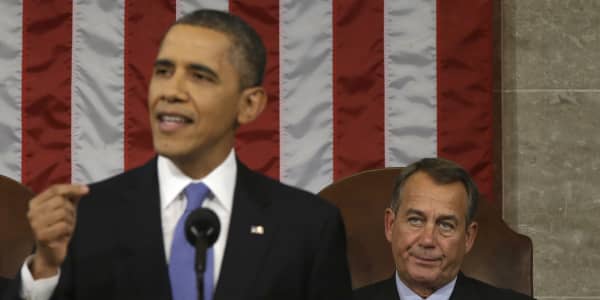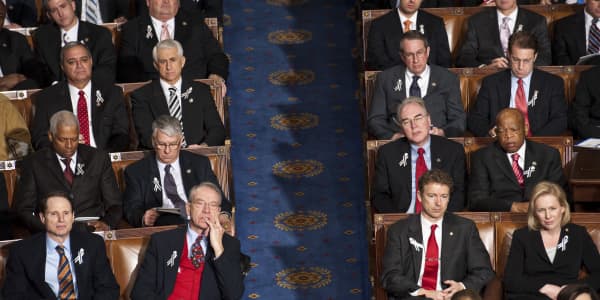11 Historic Fights Worse Than the Sequester
Sure, we're tired of hearing about the sequester and its brutal budget cuts. We're even more tired of watching Congress bicker like a bunch of spoiled children.
But it also happens to be standard operating procedure in American politics, historians say.
"This is endemic to the system, this rancor," said Jeffrey Engel, director of presidential history projects at Southern Methodist University.
Congress has always been a wild and woolly place. There was that pro-slavery senator who pulled a pistol on an anti-slavery senator. Then there was the fistfight on the House floor during an all-night debate. Oh, and don't forget that Southern congressman who nearly clubbed a northern senator to death on the Senate floor.
"In fact, I would argue that we're jaded by the fact that the previous 45 years were a remarkable period of bipartisanship—and that's the anomaly. The Cold War fostered a remarkable consensus over budget priorities," Engel said.
As alarming as the Washington budget impasse is, Engel said we'd do well to trust it will all turn out fine. "Fighting in Washington is not only part of the process, but ultimately can also lead to a lot of good," he said.
We asked Engel and Paul Croce, a historian at Stetson University, for examples of extreme partisanship in American history. Take a look through these alarming and sometimes violent fights. We're pretty sure you'll feel better about the current Washington dysfunction.
By Deborah Caldwell
Posted 12 March 2013
Whiskey Rebellion, aka Tea Party With Guns
In 1791, President George Washington faced a group of anti-tax activists—think today's Tea Party, but armed with guns—over a tax on whiskey created by Treasury Secretary Alexander Hamilton as a way to bring in revenue.
Congress passed the tax, but the farmers of western Pennsylvania who distilled and sold whiskey were outraged. Many were war veterans who contended they were fighting for the principles of the American Revolution, in particular against taxation without local representation. The federal government, on the other hand, said the taxes were legal under the taxation powers of Congress.
In July 1794, the whiskey rebels destroyed the home of a tax inspector. The rebellion grew in numbers and started to look like it would spread. Ultimately, Washington sent in 13,000 troops, who put down the rebellion.
Hanging Chads, Circa 1800
The election between Thomas Jefferson and John Adams was a doozy, since each represented a political party that believed the other guys' victory would ruin the nation.
The sitting president, John Adams, was a Federalist who attacked Jefferson as a "howling atheist" whose sympathy for the French Revolution would bring chaos to the U.S.
Meanwhile, Jefferson and the Democratic-Republican Party denounced Adams' apparent love of federal power—particularly his expansion of the Army and Navy, plus new taxes and deficit spending. Jefferson described Adams as senile, vain, and driven by an "ungovernable temper."
Ultimately the Democratic-Republicans swept both houses of Congress, including a 65 to 39 majority in the House.
But the presidential election was another matter, with the electoral college tied between Jefferson and his running mate, Aaron Burr. A month after the election—and after a week of balloting—the House finally chose Jefferson.
Despite the rancor, it was the first peaceful transition of political power between opposing parties in U.S. history and therefore had far-reaching significance.
Burr-Hamilton Duel
One of the most famous personal conflicts in American history, the Burr–Hamilton duel of July 1804, arose from a 13-year political and personal grudge.
Although the rivalry had its roots in a 1791 Senate race, it broke into the open during the presidential election of 1800.
The electoral college was at an impasse between Jefferson and Burr. Hamilton didn't support either candidate, but he couldn't stand Burr. Through Hamilton's political maneuvering in the House, Jefferson became president, with Burr his vice president.
Four years later, Burr ran for New York governor—and Hamilton campaigned against him, thereby ensuring Burr's loss. Then, Hamilton criticized Burr at a dinner party, which led to angry letters between them.
When Hamilton wouldn't apologize, Burr challenged him to a duel in Weehawken, N.J., overlooking the Hudson River. Burr shot and killed Hamilton.
The Compromise Everyone Really Hated
In 1819, the nation contained 11 free and 11 slave states. Missouri, however, wanted to join the union—as a slave state.
Everyone braced for a congressional brawl. Southern members threatened to break up the union, with one member from Georgia saying, "A fire has been kindled which all the waters of the ocean cannot put out, and which only seas of blood can extinguish."
The debate lasted for months, and was followed intensely by the public and press.
It's hard to imagine anyone these days, except Washington wonks, paying close attention to a congressional debate, but there was a standing-room-only crowd for this one. You could argue Americans were better-informed citizens back then. Or you could just admit they didn't have diversions like Facebook, YouTube, NASCAR, and HGTV.
Anyway, Henry Clay of Kentucky eventually brokered a solution: Missouri would be admitted to the union as a slave state, but balanced by the admission of Maine, a free state, which was sick of being part of Massachusetts anyway.
John Randolph denounced it as "a dirty bargain," and called the 18 Northerners who voted for it "dough-faces."
Both sides of the aisle hated the Missouri Compromise, but it lasted for 30 years.
Super-Angry About Taxes Again
This dust-up was a big turning point in the years before the Civil War.
In 1828, Congress passed the first import tax. The tariff increased the cost of imported goods and thus protected new industries of the North from competition abroad. The South, whose economy was based on the export of cotton, didn't do a lot of manufacturing.
That caused a big problem for the South because it had to either import from Europe or buy stuff made in the North, all of which was very expensive because of high taxes. The tariff became known as the "Tariff of Abominations" by super-angry Southerners.
So Congress went another round of tit-for-tat: In an elaborate plan to prevent an even bigger tax hike, Southern Democrats struck back by crafting a bill that would tax materials imported by the New England states.
The Southerners believed the New Englanders would oppose the bill and that the Southern legislators could then withdraw their support, killing the legislation—while conveniently blaming it on New England.
But the Democrats miscalculated. The New Englanders didn't sink the legislation, and it passed.
That led John Calhoun of South Carolina to write essays describing a theory of "nullification" that would allow states to ignore federal laws—which eventually led to the Nullification Crisis of the 1830s, in which South Carolina decided a state didn't have to follow federal law.
Pretty nasty. And so we continue to Civil War: The Prequel.
The Pistol Incident
The 1850s were basically one political catastrophe after another and widely considered by historians to be America's worst period outside the Civil War. There are so many examples of congressional crises that it's hard to name them all. But hey, here are a few highlights.
In March 1850, Sen. William H. Seward of New York delivered his "Higher Law" address, stating that a compromise on slavery was wrong because under a higher law than the Constitution—the law of God—all men are free.
A month later, Sen. Henry Foote of Mississippi pulled a pistol on anti-slavery Sen. Thomas Hart Benton on the Senate floor. A wrestling match ensued, but no shots were fired.
The Clubbing Incident
In 1854, hoping to attract development in the North, Illinois Sen. Stephen Douglas pushed the Kansas-Nebraska Act through Congress. The act included a provision declaring that popular sovereignty would determine the future of slavery in Kansas and Nebraska.
Southerners loved that, because the act effectively repealed the part of the Missouri Compromise that banned slavery. So as soon as the Kansas-Nebraska Act passed, Missourians poured across the state line into Kansas with their slaves.
They set up a government in Lecompton, Kan., and rigged elections to get more pro-slavery delegates sent to the constitutional convention.
That didn't sit well with Northern abolitionists, who feared Kansas would become the next slave state. So hundreds of them descended on Kansas to set up their own government in Lawrence.
By this point, members of Congress were paying attention. As was often the case, tempers flared. And then ...
A Southern congressman nearly clubbed abolitionist Sen. Charles Sumner to death on the Senate floor for speaking out against the act and its authors.
Oh, but there was still more....
The Fistfight Incident
In 1858, a fistfight among 30 congressmen divided along slavery vs. abolitionist lines took place on the floor of Congress during an all-night debate.
Had enough? We thought so. But a few years later, the Civil War was in full swing.
Occupy Wall Street, Circa 1890
The early 1890s brought a financial crash and depression that featured a railroad building bubble and a run on the gold supply.
Just like today, the nation was dealing with waves of immigrants, and Americans sensed the country was undergoing a major economic and demographic transformation. There were labor battles with police and corporations and marches on Washington.
Into that mess waded William Jennings Bryan, who led the People's Party, based among poor white farmers in the South and Plains and hostile to banks, railroads, and the One Percent of that era.
Between 1891 and 1903, 50 members of the party served in Congress, making all kinds of third party mischief by advocating public ownership of railroads and finance, opposing large military expenses and advocating a graduated income tax, the purpose of which was to secure "redistribution of the wealth."
In 1896, the Democratic Party nominated Bryan as its presidential nominee, running against Republican William McKinley.
Bryan lost, setting the stage for 36 years of Republican control of the White House, interrupted only by the two terms of Democrat Woodrow Wilson.
The Crafty Court-Packing Plan
When Democrat President Franklin Roosevelt took office at the height of the Great Depression, he began trying to stabilize the economy with experimental projects and programs known as the New Deal.These included the Tennessee Valley Authority Act, the Works Progress Administration and the National Industrial Recovery Act.
Less than three years after Roosevelt got the New Deal through Congress, however, the Supreme Court began overturning it.
So Roosevelt hatched a plan to try to outwit the conservatives on the court who didn't like his New Deal. He drafted a bill for Congress titled the "Judiciary Reorganization Bill of 1937," popularly known as the "court-packing plan," which would have added six more liberal judges.
The legislation failed when the Senate voted to return the bill to the Judiciary Committee with instructions to get rid of court-packing. The bill died in committee.
"If you think people hate President Obama, or George W. Bush, people on the opposite side of the aisle really hated Franklin Roosevelt," said SMU's Engel. "The level of political vitriol against FDR was equal to anything we've seen in recent generations."
1968: Democrats Splinter
The impact of the Vietnam War, the Civil Rights Movement and unrest on college campuses led to a major eruption in 1968—violent protests at the Democratic National Convention and the assassinations of Martin Luther King Jr. and Sen. Robert Kennedy.
The presidential election was one of the most chaotic in American history, with President Lyndon Johnson the obvious early front-runner for the Democratic nomination. But opposition to the war and urban rioting made him vulnerable. So Kennedy entered the race, prompting Johnson to drop out.
After winning the California primary in June, Kennedy gave his victory speech in a Los Angeles hotel, walked off the stage and fatally shot. Coming on the heels of the assassination of King, the nation felt like it was spinning out of control.
By July, thousands of activists descended on the Democratic Convention. There, protesters were beaten by the Chicago police, and chaos entered the convention hall. Eventually, Hubert Humphrey received the nomination.
In November, he was defeated by Republican Richard Nixon—an election that set the stage four years later for Watergate.





